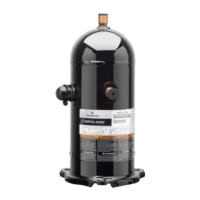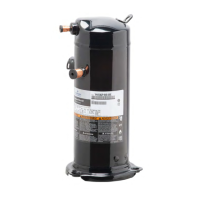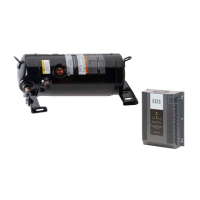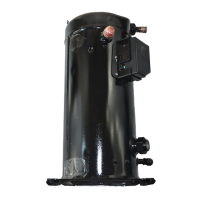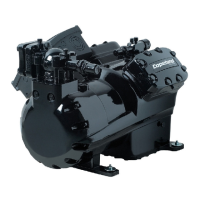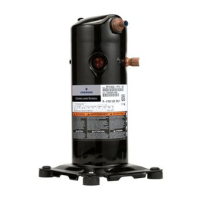AGL_HP_VS_YHV_RG_RT_EN_Rev00 19
3.9 Filter screens
CAUTION
Screen blocking! Compressor breakdown! Use screens with at least
The use of screens finer than 30 x 30 meshes (0.6 mm openings) anywhere in the system should be
avoided with these compressors. Field experience has shown that finer mesh screens used to protect
thermal expansion valves, capillary tubes or accumulators can become temporarily or permanently
plugged with normal system debris and block the flow of either oil or refrigerant to the compressor.
Such blockage can result in compressor failure.
3.10 Mufflers
Gas flow through scroll compressors is continuous with relatively low pulsation. Therefore, external
mufflers may not be required on these compressors. Due to system variability, individual system
tests should be conducted by the system manufacturer/installer to verify acceptability of sound and
vibration performance.
If adequate attenuation is not achieved, use a muffler with a larger cross-sectional area to inlet area
ratio. A ratio of 20:1 to 30:1 is recommended.
A hollow shell muffler will work quite well. Locate the muffler at minimum 15 to maximum 45 cm from
the compressor for the most eff ective operation. The f urther the muffler is placed from the
compressor within these ranges, the more effective. Choose a muffler with a length of 10 to 15 cm.
3.11 Sound shell
At this time, no sound shell attenuation for YHV*RG/RT compressors is available from Emerson. If a
sound shell is needed, particular attention shall be paid to the electrostatic charge of the insulation
material, which could be a potential ignition source
see EN 60079-0, clause 7.4.
3.12 Insulation material
Insulation material is commonly used in a system to insulate the suction line, suction accumulator,
expansion valve bulb or discharge line thermostat. When choosing the insulation material, particular
attention shall be paid to its non-electrostatic properties, as it could be a potential ignition source.
3.13 Reversing valve
A variable-speed scroll brings a significant benefit during the defrost cycle. By taking advantage of
the higher speeds and flow rates, the defrost time will typically be shorter than in a fixed-speed
compressor system, which will reduce the time electric resistance heat is used during the defrost
cycle.
Reversing valve sizing must be within the guidelines of the valve manufacturer. Required pressure
drop to ensure valve shifting must be measured throughout the operating range of the unit and
compared to
drop across the valve can result in a valve not shifting.
This can result in a condition where the compressor appears to be not pumping, ie, balanced
pressure. It can also produce elevated compressor sound levels. During a defrost cycle, when the
reversing valve abruptly changes the refrigerant flow direction, the suction and discharge pressures
will go outside of the operating envelope. The condition will usually cross the diagonal line
representing the lower right-hand side corner of the envelope. The sound that the compressor makes
during this transition period is normal, and the duration of the sound will depend on the coil volume,
outdoor ambient and system charge.
Since Copeland scroll compressors have a very high volumetric efficiency , their displacements are
lower than those of comparable capacity reciprocating compressors. As a result, Emerson
recommends that the capacity rating on reversing valves be no more than 1.5 to 2 times the nominal
capacity of the compressor in order to ensure proper operation of the reversing valve under all
operating conditions.
The reversing solenoid valve should be wired so that the valve does not reverse when the system is
shut off by the operating thermostat in the heating or cooling mode. If the valve is allowed to reverse
at system shut-off, suction and discharge pressures are reversed to the compressor. This results in
pressures equalizing through the compressor which can cause the compressor to slowly rotate until

